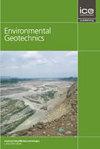用于挖掘和清洁覆盖修复的碳减排设计工具(CReDiT)
IF 2.2
4区 工程技术
Q3 ENGINEERING, GEOLOGICAL
引用次数: 0
摘要
要实现2050年的净零碳排放目标,土木工程的所有部门都必须将减少碳排放纳入其设计中。本文介绍了用于棕地遗址挖掘和清洁覆盖物修复的碳减排设计工具(CReDiT)的发展和早期成果。该工具是为这种修复技术而开发的,因为它是英国住宅重建场地使用的主要修复方法。信用额决定了这种形式的补救所涉及的复杂过程的碳排放量,例如挖掘土壤、使用原材料、运输材料和废物、回收和再利用材料。该工具的应用,以评估从挖掘和覆盖补救方案适用于前垃圾填埋场的碳排放,提出。在本案例研究中,CReDiT量化了碳排放量和拟议设计方案的材料量。它还展示了通过现场材料的有效再利用和废物对碳排放的贡献可以节省碳。通过重复使用或回收富含碳或有价值的材料而节省的额外碳也被计算在内。CReDiT的使用引发了对修复挖掘和覆盖设计的重新思考。挖掘/废料被重新评估为资源;评估材料再利用方案,并在设计过程中考虑减少碳排放。这将导致更可持续的补救解决方案。本文章由计算机程序翻译,如有差异,请以英文原文为准。
Carbon Reduction Design Tool (CReDiT) for excavation and clean cover remediation
Meeting the 2050 net zero carbon target requires all sectors of civil engineering to include the reduction of carbon emissions within their designs. This paper presents the development and early achievements of a Carbon Reduction Design Tool (CReDiT) for excavation and clean cover remediation of brownfield sites. The tool was developed for this remediation technique as it is the dominant remediation method used on residential redevelopment sites within the UK. CReDiT determines carbon emissions from the complex processes involved in this form of remediation, e.g., excavation of soil, use of raw materials, transport of material and the waste, recycling and reuse of materials. The application of the tool, to evaluate carbon emissions from excavation and cover remediation options applied to a former landfill site, is presented. In this case study, CReDiT quantifies carbon emissions and material volumes for proposed design options. It also demonstrates the carbon savings that can be made by the effective reuse of material onsite and the contribution of waste materials to carbon emissions. Additional carbon savings through the reuse or recycling of carbon-rich or valuable materials are also calculated. The use of CReDiT has led to a rethink of remediation excavation and cover design. Excavated /waste materials are re-evaluated as a resource; material reuse options are assessed and carbon reduction is included in the design process. This leads to more sustainable remediation solutions.
求助全文
通过发布文献求助,成功后即可免费获取论文全文。
去求助
来源期刊

Environmental geotechnics
Environmental Science-Water Science and Technology
CiteScore
6.20
自引率
18.20%
发文量
53
期刊介绍:
In 21st century living, engineers and researchers need to deal with growing problems related to climate change, oil and water storage, handling, storage and disposal of toxic and hazardous wastes, remediation of contaminated sites, sustainable development and energy derived from the ground.
Environmental Geotechnics aims to disseminate knowledge and provides a fresh perspective regarding the basic concepts, theory, techniques and field applicability of innovative testing and analysis methodologies and engineering practices in geoenvironmental engineering.
The journal''s Editor in Chief is a Member of the Committee on Publication Ethics.
All relevant papers are carefully considered, vetted by a distinguished team of international experts and rapidly published. Full research papers, short communications and comprehensive review articles are published under the following broad subject categories:
geochemistry and geohydrology,
soil and rock physics, biological processes in soil, soil-atmosphere interaction,
electrical, electromagnetic and thermal characteristics of porous media,
waste management, utilization of wastes, multiphase science, landslide wasting,
soil and water conservation,
sensor development and applications,
the impact of climatic changes on geoenvironmental, geothermal/ground-source energy, carbon sequestration, oil and gas extraction techniques,
uncertainty, reliability and risk, monitoring and forensic geotechnics.
 求助内容:
求助内容: 应助结果提醒方式:
应助结果提醒方式:


